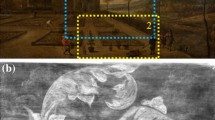Abstract
The effectiveness of terahertz (THz) imaging is dependent not only on the performances of the adopted hardware technology but also on the data processing approaches adopted by the users to elaborate the measured waveforms and obtain from them clear images of the object under test. With respect to data processing, this paper proposes a strategy involving three different steps aimed at reducing noise, filtering out undesired signal introduced by measurement system, and performing surface topography correction. The usefulness of the proposed data processing chain is preliminarily assessed by using data collected on a sample ad hoc prepared in laboratory. Afterward, an ancient mortar specimen, which is decorated by colored stucco, is analyzed by means of the proposed strategy.











Similar content being viewed by others
References
M. Bertero and P. Boccacci (1998), Introduction to Inverse Problems in Imaging, Bristol: Institute of Physics Publishing.
S. H. Jensen, P. C. Hansen, S. D. Hansen, and J. A. Sørensen, “Reduction of Broad-Band Noise in Speech by Truncated QSVD,” IEEE Trans. Speech, Audio Processing, vol. 3, no.6, pp. 439–448, Nov. 1995
S. Doclo and M. Moonen, “GSVD-based optimal filtering for single and multiple speech enhancement”, IEEE Trans. Signal Process., vol. 50, no. 9, pp. 2230–2244, Sep. 2002.
J. B. Maj, M. Moonen, and J. Wouters “Svd-based optimal filtering technique for noise reduction in hearing aids using two microphones”, EURASIP Journal on Applied Signal Processing, vol. 4, pp. 434–445, 2002.
J.-B. Maj, L. Royackers, M. Moonen, J. Wouters, SVD-Based Optimal Filtering for Noise Reduction in Dual Microphone Hearing Aids: A Real Time Implementation and Perceptual Evaluation, IEEE Trans on Biomedical Eng, vol. 52, no. 9, pp. 1563-1573, Sep. 2005
H.C Andrews and C.L Patterson “Singular Value Decompositions and Digital Image Processing”, IEEE Trans. ASSP, vol. ASSP-24, pp. 26-53, Feb. 1976.
K. Konstantinides, B. Natarajan, and G. S. Yovanof, “Noise estimation and filtering using block-based singular value decomposition”, IEEE Trans. On Image Processing, vol. 6, no. 3, pp. 479-483, Mar. 1997.
G.-P. M. Hegde and C. Ye, “Singular Value Decomposition Filter: an Effective Method to Enhance the SwissRanger SR-3000’s Range Images”, Int. J. of Intelligent Control and Systems, vol. 13, no. 4, pp. 242-250, Dec. 2008.
P.K. Sadasivan, D.Narayana Dutt, “SVD based technique for noise reduction in electroencephalographic signals”, Signal Processing, vol. 55, no. 2, pp. 179 - 189, 1996.
B. Cagnoli and T. J. Ulrych, “Singular value decomposition and wavy reflections in ground-penetrating radar images of base surge deposits”, J. of Appl. Geophys., vol. 48, no. 3, pp. 175-182, Oct. 2001.
V. Kabourek, P. Cerny and M. Mazanek, “Clutter reduction based on principal component analysis technique for hidden objects detection”, Radio Engineering, vol. 21, pp. 464-470, 2012.
S. Ebihara, “Blind seperation for estimation of near-surface interface by GPR with time-frequency distribution,” IEICE Transactions on Communication, vol. E86-B, pp. 3071-3081, 2003.
J.H. Kim, S.J. Cho, M.J. Yi, “Removal of ringing noise in GPR data by signal processing”, Geosci. J, vol. 11 (1), p. 75 − 81, Mar. 2007.
K.-C. Lee, J.-S. Ou, M.-C. Fang, “Application of SVD Noise-Reduction Technique to PCA Based Radar Target Recognition”, Progress in Electromag. Research, vol. PIER81, pp. 447–459, 2008.
I. Catapano, A. Affinito, L. Guerriero, B. Bisceglia, F. Soldovieri, “Majolica imaging with THz waves: preliminary result”, Appl. Phys. A, vol. 122, 11 pp., May 2016.
H. M. Jol, Ground Penetrating Radar: Theory and Applications, Elsevier Science, Oxford, 2009.
Acknowledgements
The authors would like to thank Prof. Paolo Arcari, who provided us the ancient stucco-decorated mortar specimen.
This research has been performed thanks to I-AMICA (Infrastruttura di Alta tecnologia per il Monitoraggio Climatico Ambientale-Infrastructure of High Technology for Environmental and Climate Monitoring)-PONa3-00363, a project of Structural improvement financed under the National Operational Programme (PON) for “Research and Competitiveness 2007–2013” co-funded with the European Regional Development Fund (ERDF) and National resources.
This paper is supported by the European Union’s Horizon 2020 research and innovation program under grant agreement No 700395, project HERACLES (HEritage Resilience Against CLimate Events on Site).
Author information
Authors and Affiliations
Corresponding author
Rights and permissions
About this article
Cite this article
Catapano, I., Soldovieri, F. A Data Processing Chain for Terahertz Imaging and Its Use in Artwork Diagnostics. J Infrared Milli Terahz Waves 38, 518–530 (2017). https://doi.org/10.1007/s10762-016-0340-3
Received:
Accepted:
Published:
Issue Date:
DOI: https://doi.org/10.1007/s10762-016-0340-3




